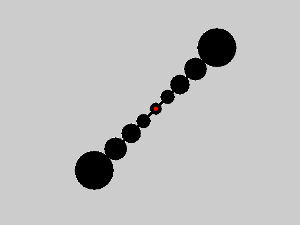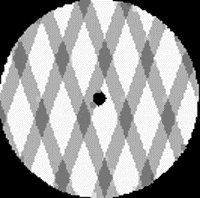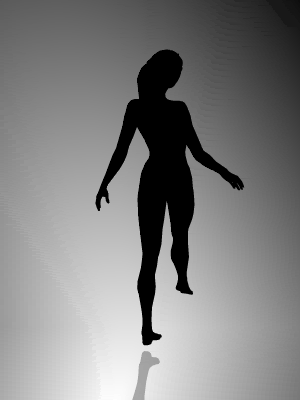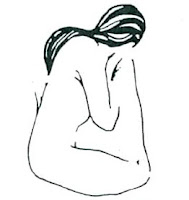--------------------------------
In this post we'll finish the tour, started in the previous post, of ambiguous figures.
Motion
Some of the most compelling illusions include things that move. Indeed, every time we watch a movie we succumb to the illusion of apparent motion. As we saw in the previous post, a rotating Necker Cube evokes vivid bistability. The present group of ambiguous figures include moving parts that are essential for the illusion.
Ambiguous structure from motion
The following video looks like a cylinder rotating either clockwise or counterclockwise (its direction is bistable). There is no cylinder drawn in the video, just a bunch of randomly placed spots. The spots' motion is set to match the velocity they would have if painted on the surface of a cylinder, and this motion signal alone is enough to give the impression of a particular shape.
It sometimes takes more than 30 seconds for the percept to switch, so you might need to watch the movie more than once. I am able to make it reverse faster by rotating my finger around the bottom of the imaginary cylinder as if I were pushing it in a new direction.
Bistable See-Saw
In the following animation, the barbell-shaped object should look like it is flipping back and forth like a see-saw. Sometimes the see-saw crosses through the horizontal axis, and other times the vertical axis. You might even see the barbell rotating 'round and 'round in a circle, though in my experience this is rare.

I lock in fairly strongly to the horizontal see-saw, but when I cover up the bottom half of the image for a few seconds, this brings out the other percept.
One Plaid or Two Gratings?
Stare at the black dot in the following animation. While initially you probably see a plaid pattern moving upward, you will eventually see two translucent sinusoidal patterns (often described as 'gratings') sliding past one another. It took me almost 30 seconds the first time before the percept switched, so stick with it.

The Spinning Girl
One of my favorite illusions. This beautiful ballerina was created by Nobuyuki Kayahara. In which direction is the ballerina doing her pirouette? Most people see her rotating clockwise initially, but the stimulus is actually ambiguous, so you can also see her rotating counterclockwise.

If you have trouble getting her to switch directions, cover her body and look only at the shadows at the bottom of the image. With the number of cues reduced, you should be able to see the shadow change direction. Once that happens, slowly lift your hand while maintaining the new direction of rotation to reveal the new pirouette direction.
This illusion has been misinterpreted as a test of handedness, or a test of whether you are right-brained or left-brained. There is no evidence for these claims, and I'm not sure where the rumors originated.
Binocular rivalry
Binocular rivalry has been a workhorse for the study of consciousness. This is partly because, in addition to the extensive psychological studies of binocular rivalry, neuroscientists have locked onto rivalry as a model for the study of the neural basis of consciousness. While we'll look more deeply at rivalry in future posts, for now we'll treat it as just another cool bistable percept.
To experience rivalry in the following image, put a piece of paper perpendicular to the screen between the two images, so your left eye sees the face and your right eye sees the house (your face should be about six inches from the screen). Be sure to fuse the checkered circles in the center of each figure. Once you obtain fusion, hold it for a while and you will experience rivalry.

Most people do not see a simple fusion of the house and face, but rather the patterns alternate. For instance, you might see the house for a few seconds, and then the face will dominate for a while, and so on. That is binocular rivalry. During transitions, the new percept will spread across the old in a kind of traveling wave, in which case you might see a dynamic quilt-like pattern.
Ambiguous forms
In this class of ambiguous figures, perception alternates between often drastically different types of objects (e.g., face and vase). These illusions are probably better known than all of the others. They are used in advertisements and art, and there are so many on the internet that I can only show a tiny sample. I won't say much about them, as the titles suggest what the two objects are supposed to be, and most of them aren't very difficult to see.
Vase versus Face
The old standby in every introductory psychology textbook.

Duck versus Rabbit
Another classic. I like the following version (from Torrey (1970)) because the two interpretations seem equally likely.

Wife/Mother-in-law and Husband/Father-in-law
On the top is a beautiful young socialite and a nasty witch-like banshee. Below is a handsome gadabout and a wretchedly distasteful lecher.

Chef versus Dog
Tilt your head to the left to see the dog, and to the right to see the goofy French chef.

Nude woman versus Reagan face

Kissing Jesters
It alternates between a single jester facing you, and two jesters facing each other, their lips lightly touching.

Gypsy versus Narcissist
The top of the image shows the ambiguous version, while the bottom shows disambiguated versions (gypsy on the left and narcissistic woman looking into the mirror on the right).

Man's face or Woman Reading?
Our last figure. I would be remiss, in a tour of ambiguous forms, if I didn't pay homage to the great surrealist Salvador Dali. His paintings are filled with beautiful and sometimes hauntingly plastic forms. The following painting, 'The Image Disappears,' was painted by Dali in 1938.

It seems somehow appropriate to let Salvador Dali be the last stop in our tour of ambiguous figures. If you have any favorites that I haven't included, please let me know in the comments or via email.
Where we are headed
While ambiguous images are intrinsically cool, they also provide a window into the nature of visual consciousness. Based on these illusions, in the next post I'll make some general hypotheses about the nature of (visual) perception. These hypotheses will give us a target for the neuronal data, to which we will then turn.
Sources of Illusions
The structure-from-motion demo is supplementary material in Krug et al. (2008). The Bistable See-Saw is adapted from the ambiguous quartet illusion, which was described by Ramachandran and Antsis (1985) (a tactile version is described in Carter et al. (2008)). The plaid/grating illusion is from Stoner et al (1990). The Spinning Girl was created by Nobuyuki Kayahara, who works in digital design. The house-face image used for binocular rivalry is from Tong et al. (1998). Vase/face goes back to Rubin (1915), but the one here is from Fischer (1967). The duck-rabbit was published originally by Jastrow (1899), but the one here is from Torrey (1970). The mother-in-law/wife image was originally published by Hill (1915), and the husband/father-in-law was originally published in Botwinick (1961). Kissing Jesters is from Fisher (1967). Chef/Dog is from Wallach and Austin (1954). Nude/Reagan is from Fisher (1968), a paper that shows 30 ambiguous forms from the history of psychology. Gypsy/Narcissist is from Fisher (1967).
References
Botwinick (1961) Husband and father-in-law: A reversible figure. American Journal of Psychology, 74: 312-313.
Carter, O, Konkle, T, Wang, Q, Hayward, V, and Moore C (2008) Tactile Rivalry Demonstrated with an Ambiguous Apparent-Motion Quartet. Current Biology 18: 1050-1054.
Fisher, G (1967), Measuring Ambiguity, American Journal of Psychology 80: 541-557.
Fischer, G (1968) Ambiguity of form: Old and new. Perception and Psychophysics 4: 189-192.
Hill, We (1915) My wife and my mother-in-law. Puck November 6.
Jastrow, J. (1899) The Mind's Eye. Popular Sci. Monthly, 54: 299-312.
Kristine Krug, Emma Brunskill, Antonina Scarna, Guy M Goodwin, Andrew J Parker (2008) Perceptual switch rates with ambiguous structure-from-motion figures in bipolar disorder. Proc. R. Soc. B, 275: 1839-1848.
Ramachandran, V.S., and Anstis, S.M. (1985). Perceptual organization in multistable apparent motion. Perception 14, 135-143.
Rubin, EJ (1915) Synsopleved Figurer: Studier i psykologisk Analyse. [If anyone has the full reference please let me know]
Stoner, GR, Albright TD, and Ramachandran VS (1990) Transparency and coherence in human motion perception. Nature 344: 153-5.
Tong, Nakayama, Vaughan, and Kanwisher (1998) Binocular rivalry and visual awareness in human extrastriate cortex, Neuron 21: 753–759
Torrey, CC (1970) Trace Localization and the Recognition of Visual Form. The American Journal of Psychology, 83: 591-600.
Wallach, H, and Austin, P (1954) Recognition and the localization of visual traces. Am J Psychol, 67:338-40.
-----------------------------------
Table of Contents of posts on consciousness.
6 comments:
In the structure from motion example, I don't think the precept of the cylinder arises simply from the motion of the dots, but rather also due to the way the dots change size and shape at the edges of the figure. This presumably is to match the dynamics of surface features "going over the horizon" as the object rotates.
Joeyo: excellent point, I hadn't noticed these differences at the boundaries.
Because of that, the example in the post isn't a pure case of structure from motion. Such boundary manipulations aren't required to get the effect, and you can see a pure demo at this site.
Looking at the spinning girl, I wonder if others see what I see, that whenever the far toe is fixated, the direction of spin reverses.
Arnold: I can't get it to switch that way. It is very hard for me to get her to switch without covering most of the figure.
I hadn't seen the spinning girl, very cool.
I tried the rivarly, but I keep seeing each image (both at the same time) or one or the other if I put my attention on one or the other. I tried for awhile--
Are there other images I might try?
A good example of the motion illusion is the lighting along the strip in Vegas--
(sonic)
Anon: this was the best example I could find, the most "pure." If you focus on truly fusing the crosshairs, and just hold it for a while, it should happen. Or perhaps you have a mutant visual system. :)
It is frankly pretty common to have an impure rivalry, and I will have a lot more to say about this, as the dynamics of the alternation are a lot more complicated than I discuss here.
The scholarpedia article on rivalry is excellent.
Post a Comment